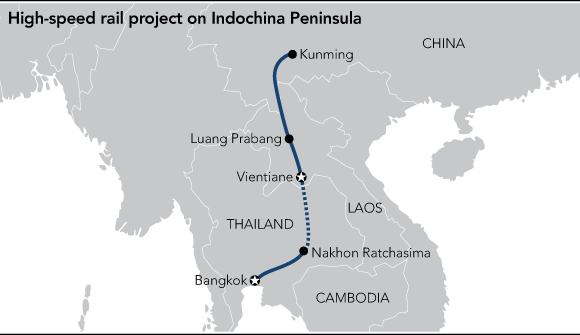Laos merely a bystander as China pushes Belt and Road ambitions
LUANG PRABANG, Laos — An ambitious $6 billion high-speed railway project in Laos that would link China with the Laotian capital of Vientiane on the Thai border is meant to be a symbol of cooperation under Chinese President Xi Jinping’s flagship Belt and Road Initiative. But with Beijing calling the shots and leaving out locals, it has instead become another example of the pitfalls faced by small Southeast Asian countries in relying economically on their much larger neighbor.
Situated about a 20-minute drive from this ancient former capital of Laos is a construction site that could be described as a little China. Workers’ conversation is all in Chinese, as is an instruction manual for heavy machinery resting on a drum. No one at the site, not even the foreman, can speak the local language.
One worker, asked where he hailed from, curtly replied “China,” adding that he was there only because his boss told him to go.
China holding the reins
Pictures posted on the fence around the construction site portray the railway scheduled to open in five years — a track winding through the mountains here, a bridge over the Mekong River there, and a sleek white train car. Also scattered around are slogans in bold print: “Belt and Road Initiative” and “win-win through cooperation.”

Chinese companies have taken the lead on construction of a high-speed railway in Laos.
The latter evokes images of the two nations working hand in hand. Yet such collaboration is not evident at the site.
Initial estimates indicated that building the railway would require 100,000 workers. For Laos, which lacks much notable industry aside from exporting hydroelectric power and mining such resources as copper and bauxite, this seemed like a golden opportunity to spur new activity and create jobs.
But these hopes have been dashed. All of the construction work was handed off to China Railway Group, and Chinese engineers and laborers have descended on the country in droves.
Not even the Laotian government is clear on the exact number of Chinese workers in the country. “We want to use local labor as much as possible, but … ” lamented Lattanamany Khounnyvong, vice minister of public works and transport, whose purview includes the rail project.
Lattanamany was alluding to the massive leverage held by China, which is shouldering 70% of the cost of the project. With no experience with railway construction, Laos “has no choice but to depend on China” for technology and personnel, Lattanamany said.
Source: https://asia.nikkei.com/Politics-Economy/International-Relations/Laos-merely-a-bystander-as-China-pushes-Belt-and-Road-ambitions


 Thailand
Thailand




